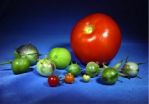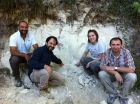(Press-News.org) A new study published in Cancer Research shows SIRT6—a protein known to inhibit the growth of liver and colon cancers—can promote the development of skin cancers by turning on an enzyme that increases inflammation, proliferation and survival of sun-damaged skin cells.
Previously considered protective, SIRT6 is part of a family of seven proteins called sirtuins that help regulate genomic stability and prevent some of the genetic flaws associated with aging. SIRT6 helps repair DNA damage, which can lead to cancer. This study, in the journal's October 15 issue, reveals its activity can vary from one tissue type to another.
"Although SIRT6 suppressed tumor growth in some cell types, we discovered that it encouraged cancer development in others, particularly in skin cells," said study author Yu-Ying He, PhD, assistant professor of medicine at the University of Chicago.
"We found more SIRT6 protein in sun-damaged squamous cell carcinoma cells than in healthy, sun-protected human skin," she said. "When we deleted SIRT6 from skin cells in mice, tumor development decreased."
To understand how SIRT6 contributed to the onset of skin cancer the researchers looked at its effects on COX-2, an enzyme responsible for inflammation. COX-2 also promotes cell proliferation and survival, however, two hallmarks of cancer cells. When the researchers increased expression of SIRT6, COX-2 became more abundant. When they inhibited SIRT6 expression, COX-2 levels decreased.
They also found that exposure to ultraviolet-B light, a cancer-causing component of sunshine, could trigger increased expression of SIRT6 in skin cells. This led to the production of COX-2, which contributed to the development of skin cancers.
"Our findings underscore a critical role for SIRT6 in the skin damage cause by ultraviolet light," He said, "This adds to our understanding of the mechanisms of skin carcinogenesis. It suggests that SIRT6 could provide a useful target for cancer prevention. We are searching for safe and effective ways to inhibit it."
INFORMATION:
The National Institutes of Health, The American Cancer Society and the University of Chicago Cancer Research Center supported the study. Additional authors were Mei Ming, Weinhong Han, Baozhong Zhao and Mahesh Gupta from the University of Chicago; Nagalongam Sundaresan from the Indian Institute of Science, Bangalore, India; and Chu-Xia Deng, from the National Institute of Diabetes, Digestive and Kidney Diseases (NIH).
Two-faced gene: SIRT6 prevents some cancers but promotes sun-induced skin cancer
2014-10-15
ELSE PRESS RELEASES FROM THIS DATE:
Study identifies risk factors for sexual assault, including age and alcohol consumption
2014-10-15
Risk factors for sexual assault, including young age and alcohol consumption, must be addressed when considering preventative strategies, suggests a new study, published today (15 October) in BJOG: An International Journal of Obstetrics and Gynaecology (BJOG).
The Danish study used data from all women attending the specialised centre for victims of sexual assault (CVSA) in Copenhagen for sexual assault or attempted sexual assault between March 2001 and December 2010. A total of 2541 women were included in the sample.
The study aimed to describe the victims of sexual ...
Teens' science interest linked with knowledge, but only in wealthier nations
2014-10-15
It seems logical that a student who is interested in science as an academic subject would also know a lot about science, but new findings show that this link depends on the overall wealth of the country that the teen calls home. The research suggests that individual science achievement may be influenced as much by broad national-level resources as it is by personal interest and motivation.
This is a photo of students in a chemistry class."Our results suggest that children with high levels of interest in science are able to turn their scientific interest into actual science ...
Many older adults still homebound after 2011 Great East Japan Earthquake
2014-10-15
A new study, published online in the journal Age and Ageing today, shows that the homebound status of adults over the age of 65 in the aftermath of the 2011 Great East Japan Earthquake is still a serious public health concern. Of 2,327 older adults surveyed, approximately 20% were found to be homebound.
A team of researchers led by Naoki Kondo of the University of Tokyo's School of Public Health studied data from the city of Rikuzentakata, an area that was seriously damaged by the disaster. Of its total population of 23,302 before the events of 2011, 1,773 people died ...
Can big data make sense of climate change?
2014-10-14
New Rochelle, October 14, 2014 –Big Data analytics are helping to provide answers to many complex problems in science and society, but they have not contributed to a better understanding climate science, despite an abundance of climate data. When it comes to analyzing the climate system, Big Data methods alone are not enough and sound scientific theory must guide data modeling techniques and results interpretation, according to an insightful article in Big Data, the highly innovative, peer-reviewed journal from Mary Ann Liebert, Inc., publishers. The article is available ...
Dinosaur breathing study shows that noses enhanced smelling and cooled brain
2014-10-14
ATHENS, Ohio (Oct. 14, 2014)—It's been millions of years since T. rex took its last breath, but a team led by Ohio University scientists is breathing life back into dinosaurs using high-powered computer simulations to model airflow through dinosaur snouts. The research has important implications for how dinosaurs used their noses to not only breathe but to enhance the sense of smell and cool their brains.
"Dinosaurs were pretty 'nosy' animals," said Ohio University doctoral student Jason Bourke, lead author of the new study published today in the Anatomical Record. ...
Mars One -- and done?
2014-10-14
In 2012, the "Mars One" project, led by a Dutch nonprofit, announced plans to establish the first human colony on the Red Planet by 2025. The mission would initially send four astronauts on a one-way trip to Mars, where they would spend the rest of their lives building the first permanent human settlement.
It's a bold vision — particularly since Mars One claims that the entire mission can be built upon technologies that already exist. As its website states, establishing humans on Mars would be "the next giant leap for mankind."
But engineers at MIT say the project ...
New sequencing reveals genetic history of tomatoes
2014-10-14
This week, an international team of researchers, led by the Chinese Academy of Agricultural Sciences in Beijing, published in the journal Nature Genetics a brief genomic history of tomato breeding, based on sequencing of 360 varieties of the tomato plant.
The C.M. Rick Tomato Genetics Resource Center at UC Davis played an important role in this study by providing seed of both cultivated tomato varieties and related wild species.
This study, which builds on the first tomato genome sequence completed just two years ago, shows in great detail how the processes of early ...
Photopharmacology: Optical control of insulin secretion
2014-10-14
Researchers at Ludwig-Maximilians-Universitaet (LMU) in Munich have chemically modified an anti-diabetic agent so as to make its action dependent on light. The resulting prototype compound, termed JB253, induces release of insulin only when pancreas cells are exposed to blue light.
Synthetic, light-sensitive, molecular switches can be utilized to control biochemical signaling processes in living cells. In a new study, a research team led by LMU Professor Dirk Trauner (Chemical Biology and Genetics) and his colleague Johannes Broichhagen, in collaboration with Prof. Guy ...
Earth's magnetic field could flip within a human lifetime
2014-10-14
Imagine the world waking up one morning to discover that all compasses pointed south instead of north.
It's not as bizarre as it sounds. Earth's magnetic field has flipped – though not overnight – many times throughout the planet's history. Its dipole magnetic field, like that of a bar magnet, remains about the same intensity for thousands to millions of years, but for incompletely known reasons it occasionally weakens and, presumably over a few thousand years, reverses direction.
Now, a new study by a team of scientists from Italy, France, Columbia University ...
House fly genome reveals expanded immune system
2014-10-14
ITHACA, N.Y. – Scientists have sequenced the house fly genome for the first time, revealing robust immune genes, as one might expect from an insect that thrives in pathogen-rich dung piles and garbage heaps.
The research, published Oct. 14 in the journal Genome Biology, will increase understanding of house fly genetics and biology and of how flies quickly adapt to resist insecticides, which could lead to novel control methods.
Adult house flies (Musca domestica) carry and transmit more than 100 human and animal diseases, including salmonellosis, anthrax, typhoid ...


